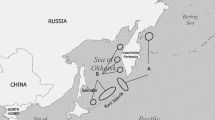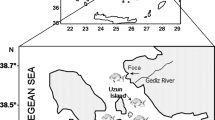Abstract
Analysis of DDT contamination in selected finfish and shellfish species from estuarine and coastal marine waters of New Jersey (USA) reveals consistently highest organochlorine pesticide levels in samples from the north and northeast regions of the state. The mean concentrations of DDT and its metabolites, DDE and DDD, in bluefish, striped bass, weakfish, and blue crabs collected at 27 stations throughout the state between 1988 and 1991 ranged from <25 to >300 μg/kg wet weight (wet wt). Gas chromatographic analysis of 175 tissue samples from these four species showed that the highest levels of DDTs (DDT plus DDE and DDD), exceeding 300 μg/kg wet wt, occurred in blue crabs (hepatopancreas) from the Hudson—Newark—Raritan Bay complex in the northeast region. Lower mean concentrations of DDTs (<200 μg/kg wet wt) were recorded in tissue samples of these species from all other regions of the state. The lowest levels of DDT contamination (mean <110 μg/kg wet wt) were found in samples from the south coast region. The greatest impact of DDT contamination is nearby metropolitan areas of the state, although the total concentrations of DDT in tissue samples from these areas are far less than the U.S. Food and Drug Administration action level of 5,000 μg/kg wet wt for this contaminant.
Similar content being viewed by others
References
Bopp R (1991) Sediment transport. In: Studholme AL, Ingham MC, Pacheco A (eds) Response of the Habitat and Biota of the Inner New York Bight to Abatement of Sewage Sludge Dumping. NOAA Technical Memorandum NMFS-F/NEC-82, US Department of Commerce, Woods Hole, MA, pp 15–18
Fishbein L (1974) Chromatographic and biological aspects of DDT and its metabolites. J Chromatogr 98:177–251
Hauge P, Bukowski J, Morton P, Boriek M, McClain J, Casey G (1990) Polychlorinated biphenyls (PCBs), chlordane, and DDTs in selected fish and shellfish from New Jersey waters, 1986–1987: results from New Jersey's Toxics in Biota Monitoring Program, Final Technical Report. New Jersey Department of Environmental Protection and Energy, Trenton, NJ, 66 pp
Hauge P (1993) Polychlorinated biphenyls (PCBs), chlordane, and DDTs in selected fish and shellfish from New Jersey waters, 1988–1991: results from New Jersey's Toxics in Biota Monitoring Program, Final Technical Report. New Jersey Department of Environmental Protection and Energy Technical Report, Trenton, NJ, 95 pp
Johnston R (1976) Mechanisms and problems of marine pollution in relation to commercial fisheries. In: Johnston R (ed) Marine Pollution, Academic Press, London, pp 3–156
Kennish MJ (1992) Ecology of Estuaries: Anthropogenic Effects. CRC Press, Boca Raton, FL 494 pp
Kennish MJ, Belton TJ, Hauge P, Lockwood K, Ruppel BE (1992) Polychlorinated biphenyls in estuarine and coastal marine waters of New Jersey: a review of contamination problems. Rev Aquat Sci 6:275–293
Kennish MJ, Ruppel BE (1996) PCB contamination in selected estuarine and coastal marine finfish and shellfish of New Jersey. Estuaries in press
Metcalf RL (1973) A century of DDT. J Agric Food Chem 21:511–519
Murty AS (1986) Toxicity of Pesticides to Fish, Vol. 1. CRC Press, Boca Raton, FL, 178 pp
Reutergardh L (1980) Chlorinated hydrocarbons in estuaries. In: Olausson I, Cato I (eds) Chemistry and Biogeochemistry of Estuaries. John Wiley & Sons, Chichester, pp 349–365
US Environmental Protection Agency (1976) Manual of analytical quality control for pesticides in human and environmental media. EPA 600/1–76–017, Health Effects Research Laboratory, Research Triangle Park, NC
— (1980) Manual of analytical methods for analysis of pesticides in human and environmental samples. EPA 600/8–80–038, Health Effects Research Laboratory, Research Triangle Park, NC
Young DR, Gossett RW, Heesen TC (1988) Persistence of chlorinated hydrocarbon contamination in a California marine ecosystem. In: Wolfe DA, O'Connor TP (eds) Coastal Processes in Marine Pollution, Vol. 3: Urban Wastes in Coastal Marine Environments. Robert E. Krieger Publishing, Malabar, FL, pp 34–41
Author information
Authors and Affiliations
Rights and permissions
About this article
Cite this article
Kennish, M.J., Ruppel, B.E. DDT contamination in selected estuarine and coastal marine finfish and shellfish of New Jersey. Arch. Environ. Contam. Toxicol. 31, 256–262 (1996). https://doi.org/10.1007/BF00212375
Received:
Revised:
Issue Date:
DOI: https://doi.org/10.1007/BF00212375




